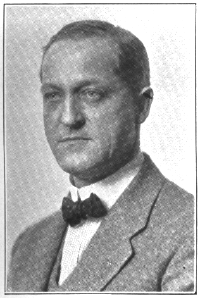John Paulding (sculptor)
John Paulding | |
|---|---|
 | |
| Born | April 5, 1883 |
| Died | April 15, 1935 (aged 52)[1] |
| Nationality (legal) | American |
| Education | The Art Institute of Chicago |
| Known for | Sculptor |

John Paulding (April 5, 1883 – April 15, 1935) was an American sculptor best remembered for his World War I memorials. Paulding was born in Darke County, Ohio. He studied sculpture at the Art Institute of Chicago and remained in Chicago until his death in 1935 at age 52.[4]
At least two of his World War I memorials became very popular and casts of them can be found in many places throughout the United States.
Controversy with E. M. Viquesney[edit]
Paulding and sculptor E. M. Viquesney both produced very similar World War I monuments within a few months of each other, resulting in various copyright violation lawsuits.[3]
Works[edit]
- American Doughboy, 1920.
- Ardmore, Oklahoma, at Walter W. Drew's gravesite in Rosehill Cemetery.[5]
- Bay City, Michigan
- Northampton, Pennsylvania
- Olathe, Kansas
- Paducah, Kentucky
- Pueblo, Colorado
- Racine, Wisconsin
- Saline, Michigan
- Van Buren, Missouri[6]
- Second-Lieutenant Francis Lowry Memorial, Fairmount Cemetery, Denver, Colorado, 1921. The fallen aviator after whom Lowry Air Force Base was named.
- Major-General James B. McPherson (The Reconnoissance), Memorial Park, McPherson County Courthouse, McPherson, Kansas, 1917.
- Over the Top, 1921.
- Albany, Missouri[7]
- Amarillo, Texas
- Astoria, Oregon
- Bolton Landing, New York
- Buffalo, New York[8]
- Catskill, New York
- Chicago, Illinois[9]
- Chillicothe, Ohio
- Cincinnati, Ohio
- Elgin, Illinois[10]
- Evanston, Wyoming[11]
- Freeburg, Illinois
- Jonesboro, Arkansas[12]
- Knoxville, Tennessee[13]
- Ladysmith, Wisconsin[14]
- Leavenworth, Kansas[15]
- Llano, Texas
- Manitou Springs, Colorado
- Marshall, Missouri
- Martins Ferry, Ohio
- McMinnville, Oregon
- Missoula, Montana[16]
- Newberry, South Carolina
- Norfolk, Nebraska[17]
- Onaga, Kansas[18]
- Pittsburgh, Pennsylvania
- Salem, Oregon (Over the Top to Victory)[19]
- South Haven, Michigan
- Valentine, Nebraska
- Wahpeton, North Dakota
- Wautoma, Wisconsin
- Wheaton, Illinois[20]
- Williamsport, Maryland
- Winner, South Dakota
-
Major-General McPherson (1917), McPherson County Courthouse, McPherson, Kansas.
-
Lowry Memorial (1921), Fairmount Cemetery, Denver, Colorado.
-
Over the Top (1921), Llano, Texas.
See also[edit]
- Astoria Victory Monument, Astoria, Oregon
References[edit]
Wikimedia Commons has media related to John Paulding (sculptor).
- ^ "Illinois, Cook County Deaths, 1878–1994". FamilySearch. The Church of Jesus Christ of Latter-day Saints. May 17, 2016. Retrieved December 21, 2016.
- ^ "World War I Memorial, (sculpture)". Smithsonian Institution Research Information System. Smithsonian Institution. Retrieved December 21, 2016.
- ^ a b Kopel, Les; Goldsmith, Earl. "The Doughboy "War": E.M. Viquesney vs. John Paulding". The E.M.Viquesney Doughboy Database. Retrieved September 1, 2013.
- ^ Opitz, Glenn B, editor, Mantle Fielding's Dictionary of American Painters, Sculptors & Engravers, Apollo Book, Poughkeepsie NY, 1986 p 703
- ^ "This and That Newsletter". OklahomaHistory.net. Butch and Jill Bridges. Retrieved December 21, 2016.
The WalterDrew2.jpg picture confirms the work was done by Paulding.
- ^ "Soldiers Monument, (sculpture)". Smithsonian Institution Research Information System. Smithsonian Institution. Retrieved December 21, 2016.
- ^ "Over the Top, (sculpture)". Smithsonian Institution Research Information System. Smithsonian Institution. Retrieved December 21, 2016.
- ^ "Over the Top to Victory, (sculpture)". Smithsonian Institution Research Information System. Smithsonian Institution. Retrieved December 21, 2016.
- ^ Paulding, John. "Over the Top". Siris-artinventories.si.edu. Retrieved December 7, 2017.
- ^ Paulding, John (December 7, 2017). "World War I Soldier". Siris-artinventories.si.edu. Retrieved December 7, 2017.
- ^ "Uinta County War Memorial". Smithsonian Collections Search Center. Smithsonian Institution. Retrieved December 15, 2016.
- ^ "World War I Markers and Memorials". The Encyclopedia of Arkansas History & Culture. The Central Arkansas Library System. Retrieved December 21, 2016.
- ^ Paulding, John (December 7, 2017). "Doughboy". Siris-artinventories.si.edu. Retrieved December 7, 2017.
- ^ Paulding, John (December 7, 2017). "Over the Top". Siris-artinventories.si.edu. Retrieved December 7, 2017.
- ^ "Doughboy (sculpture)". Smithsonian Institution Research Information System. Smithsonian Institution. Retrieved December 21, 2016.
- ^ Paulding, John (December 7, 2017). "Over the Top to Victory". Siris-artinventories.si.edu. Retrieved December 7, 2017.
- ^ "Veteran Memorial, (sculpture)". Smithsonian Institution Research Information System. Smithsonian Institution. Retrieved December 21, 2016.
- ^ "The Charging Doughboy, (sculpture)". Smithsonian Institution Research Information System. Smithsonian Institution. Retrieved December 21, 2016.
- ^ Paulding, John (December 7, 2017). "Over the Top to Victory". Siris-artinventories.si.edu. Retrieved December 7, 2017.
- ^ ""Over the Top to Victory" Doughboy Statue - Wheaton, IL - World War I Memorials and Monuments on Waymarking.com". Waymarking.com. Retrieved December 7, 2017.



